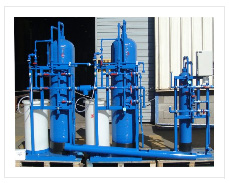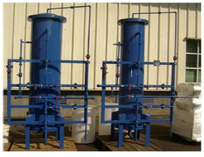Demineralizers
Demineralizer equipment use ionic interchange resins to eliminate the water ions. The produced demineralized water is used mainly in high pressure boilers and in the pharmaceutical or clinic industry. Aguasin offers its clients the standard lines of demineralizer in the manual or automatic versions.
Due to the diverse nature of the water, each application must be analysed to ensure an optimum result, technically and economically.
In Aguasin we count with professionals dedicated to delivering the best solutions. Contact Us and we will answer your request.

Co-Corrientes/Contracorrientes
The demineralizers are equipment which use ion exchange resins to remove ions of water. The positive ions or cations are removed by cation resin bed and negative ions or anions through a bed of anion resin. As these beds must be regenerated with an an acid and an alkali respectively. The flow direction of the regenerant and water may occur in the same direction (co-current) or can occur in reverse (counter-current). The choice between them depends on the type of application and technical feasibility.
Electro-Deionization
Continuous Electro Deionization (CEDI) is a process which uses a combination of ionic interchange membranes, ionic interchange resins, and an electric field of continuous current to deionize the water. The standard designs to obtain purified water, water for injections, and high purity water use a combination if inverse osmosis and continuous electro deionization. With this design, the process CEDI can produce water with specific ion concentrations near of inferior to the limits of instrumental detection. The CEDI process is widely accepted for the production of high purity water in the pharmaceutical industry, micro-electronics and energy production.
Packed Bed
The demineralized of packed beds are equipment (cation and anion) in which the resin occupies the entire volume of the body that contains it. In this case, flows are always in counter-current and available solid or packed bed, consumption of regenerating and washing water is lower relative to the traditional design and bodies are significantly smaller. The packed bed demineralized requires auxiliary equipment for the washing of resin.
Mixed Beds
The mixed-bed demineralizers are equipment which have cation and anion resins, but consist of a single body that contains them both. The resins are intimately mixed during the operation and should be separated by an upward water flow in order to regenerate with acid and soda. Then, move the excess regenerant, washed and mixed with air to return to your bed for a new cycle of operation.
Manuals and Automatic
Manual Demineralizators
AGUASIN demineralizators series S and SMA, CA and CAT models, of manual operation, are designed to produce water with low salt content, providing a minimum quality of 20 000 [ohm-cm] and 200,000 [ohm-cm], respectively . S-1 teams are made of PVC and S-3 teams above are made of steel and coated with epoxy resins are highly resistant to corrosion. They have a diaphragm valve manifold resistant top acid and alkali.Quality control of demineralized water is made using a conductivity meter, warning by the control light that changes color or an alarm when water is not within the range of required quality.
Automatic Demineralizers
The AGUASIN demineralizers series SAF, automatic operation, deliver a minimum quality of 20 000 [ohm-cm]. The vertical cylindrical shaped body is made of fiber reinforced. It has an automatic autotrol valve, which allows carrying out the service, regeneration, washing and backwashing. This valve has on its front control panel, indicating the conductivity of the effluent, the process by which the computer is located, etc.
